A micromechanics based ductile damage model for anisotropic titanium alloys
Abstract
The hot-workability of Titanium (Ti) alloys is of current interest to the aerospace
industry due to its widespread application in the design of strong and light-weight
aircraft structural components and engine parts. Motivated by the need for accurate
simulation of large scale plastic deformation in metals that exhibit macroscopic plastic
anisotropy, such as Ti, a constitutive model is developed for anisotropic materials
undergoing plastic deformation coupled with ductile damage in the form of internal
cavitation. The model is developed from a rigorous micromechanical basis, following
well-known previous works in the field. The model incorporates the porosity and
void aspect ratio as internal damage variables, and seeks to provide a more accurate
prediction of damage growth compared to previous existing models. A closed form
expression for the macroscopic yield locus is derived using a Hill-Mandel homogenization
and limit analysis of a porous representative volume element. Analytical
expressions are also developed for the evolution of the internal variables, porosity
and void shape. The developed yield criterion is validated by comparison to numerically
determined yield loci for specific anisotropic materials, using a numerical limit
analysis technique developed herein. The evolution laws for the internal variables are
validated by comparison with direct finite element simulations of porous unit cells.
Comparison with previously published results in the literature indicates that the new
model yields better agreement with the numerically determined yield loci for a wide
range of loading paths. Use of the new model in continuum finite element simulations of ductile fracture may be expected to lead to improved predictions for damage
evolution and fracture modes in plastically anisotropic materials.
Citation
Keralavarma, Shyam Mohan (2008). A micromechanics based ductile damage model for anisotropic titanium alloys. Master's thesis, Texas A&M University. Available electronically from https : / /hdl .handle .net /1969 .1 /ETD -TAMU -2620.


